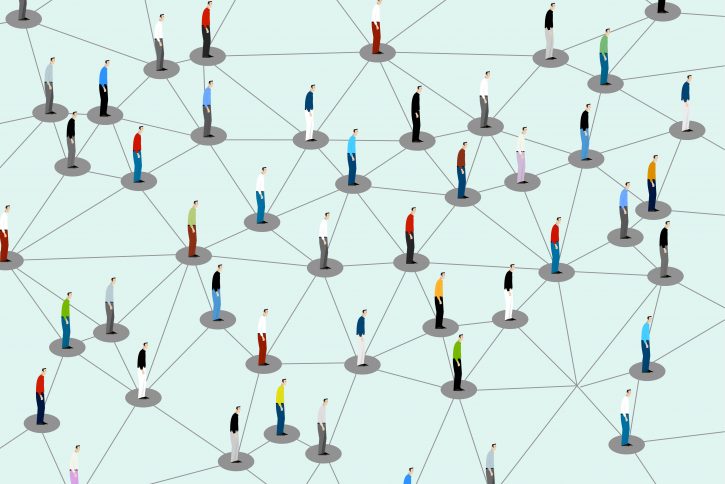
Article originally published December 21, 2020.
Social distancing, contact tracing, isolation and quarantine have become common phrases in the world of COVID-19. You have heard time and time again that you should keep your social circle small and decrease interactions with individuals outside of your household, and – in many cases – you may be doing exactly that. But what if we told you your “COVID Bubble” is likely a lot larger than you think?
By completing your own contact tracing, you can quickly see how the people you interact with – and the people they interact with – can impact your risk of exposure to COVID-19. During a season in which gathering with family and friends is practically second nature, this lesson has become more important than ever.
Read on to learn more about COVID-19 “bubbles” – and why they might not work as well as you think they do.
The “Bubble” Concept
The “bubble” concept, which is geared toward slowing the transmission of infectious diseases, gained speed shortly after the global spread of the novel coronavirus. Most simply, your “bubble” is an unofficial term for the group of people you spend time with, both within and outside of your household. This bubble could include your family, coworkers, a select group of friends and anyone else you see on a regular basis.
In theory, the smaller your bubble, the lower your risk of contracting COVID-19. Unfortunately, this concept can give many a false sense of security. Here’s why.
Overlapping “Bubbles”
At first glance, your bubble may appear small and well controlled. In reality, your bubble likely overlaps with tens (or even hundreds) of others.
For example, each person in your bubble has their own bubble. And each person in that bubble has another bubble. Depending on how dedicated you are to contact tracing, this expansion can go on and on, becoming a dizzying web of potential exposures. To put it into more concrete terms, take a minute to think of your own life and relationships.
First and foremost, who is in your bubble? Include coworkers, family members and friends.
Now, think of each member individually. How many family members do they each have? Are their children attending in-person classes? Do they, or their spouse, work in an office environment or as an essential employee? Does their daughter work at a local grocery store? Does their son attend basketball practice? As you continue to think in terms of these branching contacts, you may be surprised to find how large your bubble truly is.
How Big is Your Bubble, Really?
Your bubble: 5 people
Member One: 15 people
Member Two: 12 people
Member Three: 5 people
Member Four: 10 people
Member Five: 4 peopleIn addition to the 5 people in your bubble, you are also (unknowingly) linked to the 46 people in their combined bubbles. This number of contacts continues to grow as you look at the social interactions within each overlapping group.
Bursting “Bubbles”: The Dangers of Gathering
Based on the example above, it’s easy to see why gatherings have been deemed high risk. Even though you have made every effort to be careful (keeping your circle small, wearing your mask, sanitizing your hands), the 50+ people you are unknowingly linked to may not be taking COVID-19 quite as seriously. And while you wouldn’t intentionally carry those risks to your loved ones, you may be bringing them along with you anyway.
In fact, by the end of the gathering, your family and friends may have “invited” hundreds of people (and their germs) to your celebration.
This concept of overlapping bubbles, along with possibility of spreading COVID-19 without symptoms (or before symptoms appear), highlights the importance of avoiding crowds and gatherings: even with people we love and trust.
Managing Your “Bubble”
While the “bubble” method isn’t perfect, it can still be a useful tool for monitoring and tracking your potential exposures. To make your bubble as safe as possible, consider the following guidelines:
- When choosing your members, be clear and honest about your expectations. Consider connecting virtually with anyone that doesn’t share the same level of concern or respect for guidelines.
- Keep your bubble consistent. No matter the size, adding or changing members increases your risk of exposure.
- Continue wearing your mask and maintaining 6 feet of distance between yourself and others – even members of your established group.
- Be considerate of your bubble. If you or someone you interact with is linked to a high-risk individual, take extra precautions to protect those who are medically vulnerable.
- If you interact with someone outside of your bubble, take note. This can help with contact tracing should you need it.
- If you or someone in your bubble tests positive, the entire group should be prepared to quarantine or self-isolate.
Mapping Your “Bubble”
Use the document below to create a visual map of your bubble:
Were you surprised by the number of people in your extended bubble? It’s easy to see how our choices are all connected – and how working to protect ourselves and others can have a huge impact. Remember: for every person you see, there are dozens you don’t.
